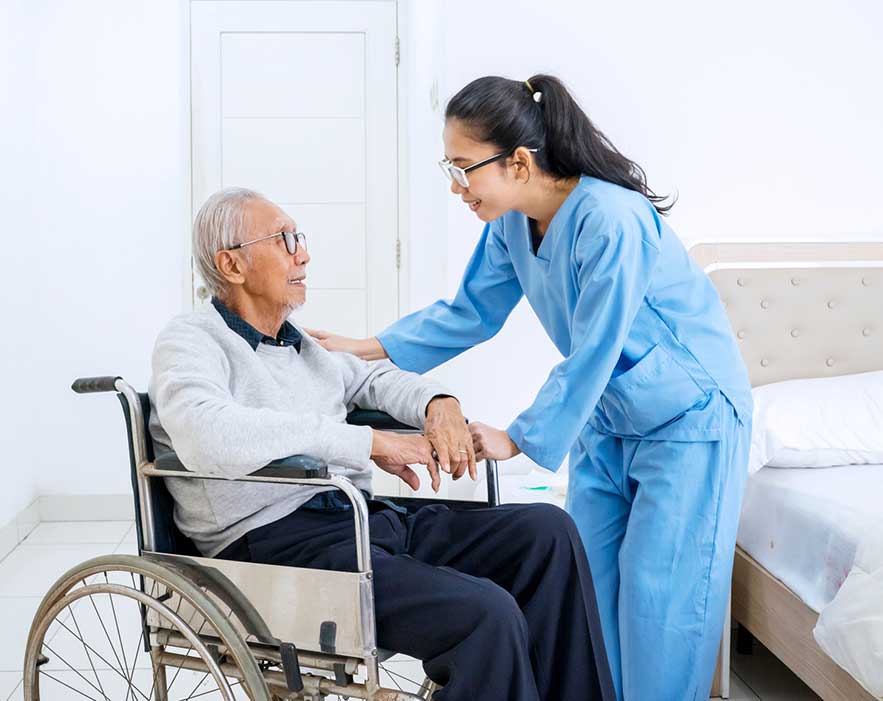Creaky Knees? Don’t Just Sit There!

The demand for knee replacements from those age 45 to 64 has tripled in the past 10 years to more than 254,000 in 2009, the latest year for which statistics are available according to “Baby Boomers’ demand, expectations for new knees soar,” in USA Today. This increase may be a result of the many baby boomers who have led active lives—skiing, hiking, running, bicycling—and want to stay fit into their older years. While many turn to knee replacement surgery, it often can be delayed or prevented by exercise.
Causes of Knee Problems
Unfortunately, aging is one of the risk factors for developing knee pain. The older we get, the more wear and tear we experience. As the largest joint in the body, one that bears much of the body’s weight when walking and running, the knee is vulnerable to deterioration. A lifetime of exercising and moving takes a toll on cartilage, made worse by the fact that older bodies don’t recover from injuries as quickly as they once did and that we tend to gain weight as we age.
A primary cause of knee pain in older adults is osteoarthritis, which occurs when articular cartilage breaks down around the knee. Cartilage acts as a cushion or shock absorber, and when this padding is lost, bones grind together, causing pain, bone spur formation and decreased motion. Cartilage degeneration can cause chronic joint inflammation, resulting in swelling or stiffness and a loss of flexibility. Over time, this inflammation can further break down cartilage, and if left untreated, cartilage may wear away completely.
Osteoarthritis, which can affect any of the body joints, is one of the five leading causes of disability among older men and women. The risk for disability from this form of arthritis is as great as that from cardiovascular disease (“Aging Knee,” Lifebridge Health).
As we age, the ability of cartilage to heal itself decreases, and muscles, in general, may shrink in size by roughly 40 percent, which reduces strength. To compensate, we may put more pressure on muscles in the hips and legs, leaving us more vulnerable to knee pain.
Genetics and gender play a role too. After the age of 50, women are more likely to develop chronic knee pain than men, and the robustness of cartilage you inherited from your parents can mean the difference between more or less cartilage deterioration.
One of the biggest factors for developing osteoarthritis is weight, because the more you weigh, the greater load your knees have to bear. Shedding extra pounds can make a big difference. Every pound of body weight is equal to five extra pounds of force on your knees (“Hip and Knee Replacements on the Rise,” WebMD).
Researchers are investigating other risk factors, including the impact of vitamins C and D deficiency, poor posture or bone alignment, poor aerobic fitness and muscle weakness.
How Surgery Works
Knee replacement surgery is the most common type of joint replacement surgery. During the operation, the surgeon makes an 8- to 12-inch cut in front of the knee, removes the damaged part of the joint from the bones’ surfaces and shapes the surfaces to hold a metal or plastic artificial joint. The artificial joint is attached to the thigh bone, shin and knee cap, either with cement or a special material. When fit together, the attached artificial parts form the joint, relying on the surrounding muscles and ligaments for support and function (WebMD).
Those who get a knee joint replacement stay in the hospital, on average, three to five days and start experiencing dramatic improvement in the use of their knee one month or more after surgery, although most people aren’t walking on their own until six weeks after the surgery.
An emerging procedure, not yet widely used or researched, is minimally invasive surgery, which employs specialized techniques and instruments to enable the surgeon to perform major surgery without a large incision. The smaller incision, 3 to 5 inches, results in less tissue damage by allowing the surgeon to work between the fibers of the quadriceps muscles instead of cutting through the tendon. This method may lead to less pain, decreased recovery time and better motion due to less scar tissue formation.
A downside to knee replacement surgery is the lack of research to determine the implant’s longevity and whether another will be necessary. People are encouraged to talk with their physician about potential future complications.
In many cases, doctors encourage patients with knee problems to try other approaches first, including physical therapy, weight loss, range-of-motion exercises, stretches and devices that offer knee support. Doctors also advise switching to exercises easier on the knee, such as running on a treadmill instead of pavement, and to work out in moderation.
Best Types of Exercise
Knee experts recommend three types of exercise. While stretching helps maintain or increase flexibility and also relieve knee stiffness, strengthening workouts aid in preserving or improving muscle strength, which supports and protects arthritic joints. Aerobic or endurance exercises boost heart function, enhance blood circulation and help control weight. Some studies show that aerobic exercise can reduce swelling in some joints.
Good exercises for osteoarthritis are low-impact, including swimming. Stretching, such as with tai chi or yoga, before and after you exercise is also important.
One way to take pressure off the knees is to pay attention to and strengthen the muscles around the knees, which adds much-needed joint support. To develop surrounding muscles—particularly quadriceps and hamstrings—as well as core muscles—obliques, lower back, upper thigh—WebMD suggests knee extensions, hamstring curls, leg presses and flexibility exercises.
Here are a few simple exercises you can do at home …
Stretching and Strengthening Exercises
Movements that stretch the muscles around the knee include:
Quadriceps stretch: While standing, place your right hand on the wall or the back of a chair for support. Bend your left leg behind you, and grab it just above the ankle with your left hand. Pull the ankle backward toward your buttocks. Tighten your tummy and tuck your buttocks in. Hold the stretch for a few seconds, then release and stretch the other leg.
Forward bend: Stand with your feet a few inches apart and knees slightly bent. Bend forward from the waist and reach for your toes. Go only as far as is comfortable. Let your arms hang loosely. Hold the stretch for five slow breaths, then gradually come back up. Try to feel yourself unrolling one vertebra at a time until you’re standing straight again.
For strengthening exercises:
Quadriceps lift: Sit up straight in a chair, both feet on the floor, and tighten your abdomen. Extend one leg in front of you, with your toes pointing upward. Raise your thigh off the chair slightly. Lower your thigh and repeat. Then switch and continue with the other leg.
Side leg raise: Stand with your hands on the back of a chair with your feet slightly apart. Slowly raise your right leg to the side. Make sure your left knee is somewhat bent and your back is straight. Keep right leg raised for one second. Lower the leg, then repeat 10 to 15 times. Now switch legs and do 10 to 15 side raises with your left leg. Complete two sets of this exercise.
Sources
“Smart Exercises for Knee Arthritis,” CNN Health(from the Arthritis Foundation)
“Aging Knee,” Lifebridge Health
“Causes of Knee Problems in the Elderly,” Oct. 24, 2013Live Strong.com
“Hip and Knee Replacements on the Rise,”WebMD
“Knee Exercise: Strengthen Quads for Healthy Knees,”About.com Senior Living
“Knee Replacement Surgery for Arthritis,”WebMD
“Knee Strengthening Exercises,” Knee Pain Explained
“What Are Knee Problems? Fast Facts: An Easy-to-Read Series of Publications for the Public,” National Institute of Arthritis and Musculoskeletal and Skin Diseases
“Why Knee Pain Worsens With Age,” Everyday Health
Reprinted by Always Best Care Senior Services with permission from Senior Spirit, the newsletter of the Society of Certified Senior Advisors.
The Certified Senior Advisor (CSA) program provides the advanced knowledge and practical tools to serve seniors at the highest level possible while providing recipients a powerful credential that increases their competitive advantage over other professionals. The CSA works closely withAlways Best Care Senior ServicesAlways Best Care Senior Servicesto help ABC business owners understand how to build effective relationships with seniors based on a broad-based knowledge of the health, social and financial issues that are important to seniors, and the dynamics of how these factors work together in seniors’ lives. To be a Certified Senior Advisor (CSA) means one willingly accepts and vigilantly upholds the standards in the CSA Code of Professional Responsibility. These standards define the behavior that we owe to seniors, to ourselves, and to our fellow CSAs. The reputation built over the years by the hard work and high standards of CSAs flows to everyone who adds the designation to their name..
Always Best Care Senior Services®
Founded in 1996, Always Best Care Senior Services is based on the belief that having the right people for the right level of care means peace of mind for the client and family. Always Best Care assists seniors with a wide range of illnesses and personal needs, and currently provides more than 3 million hours of care every year. Franchise opportunities are available to individuals interested in leveraging the company’s clear strategy and proven track record for delivering affordable, dependable service to seniors in their local areas.
By working with case managers, social workers, discharge planners, doctors, and families, Always Best Care franchise owners provide affordable, comprehensive solutions that can be specifically matched to meet a client’s particular physical or social needs. The hallmark services of the Always Best Care business portfolio include non-medical in-home care and assisted living finder and referral services, with skilled home health care now being phased in throughout the country. For more information, visit Always Best Care.For franchise opportunities, visit www.FranchiseWithAlwaysBestCare.com
Always Best Care also offers Always in Touch, a telephone reassurance program that provides a daily phone call to seniors and disabled adults who are living alone and have limited contact with the outside world. Always in Touch is the only absolutely free national telephone reassurance program of its kind anywhere in the USA and Canada. For more information on Always in Touch, or to request an application, visit www.Always-in-Touch.com.
Another special program from Always Best Care is Always on Call –provided free to Always Best Care clients and their families with a minimum of 5 hours of monthly care. Families will have anytime access to physicians 24/7 if they’re considering ER or urgent care for non-emergency issues, if they need a non-narcotic prescription or refill, if they can’t take time off from work or school, if they’re traveling and need medical care, if their primary physician is not available, or if they have a sick child, spouse or elderly parent. This special service is provided to Always Best Care clients and their families by 24HourMDNow, an independent company not affiliated with Always Best Care.
May, 2014
To print this article CLICK HERE




